#Stereographic negatives
Photo

🔸 This idyllic photograph entitled “window call” was taken by William Morris Grundy in 1857. He captures the rural life in England during the Victorian era. Born in Birmingham in 1806, Grundy took up photography in 1855 and made dozens of stereoscopic photos, primarily posed genre scenes of rustic pursuits such as hunting, fishing, and farming. The London Stereoscopic Company bought about 200 of his negatives, and individual stereographs still exist. However, Grundy’s work is best known for the twenty original albumen prints based into the anthology Sunshine in the Country, A Book of Rural Poetry Embellished with Photographs from Nature (London, 1861). #victorianchaps #oldphoto #victorian #vintage #goodolddays #rurallife #1850s #nostalgia #williammorrisgrundy #pastlives #history #england #retro #fashion https://www.instagram.com/p/CpBAOeVjiCt/?igshid=NGJjMDIxMWI=
#victorianchaps#oldphoto#victorian#vintage#goodolddays#rurallife#1850s#nostalgia#williammorrisgrundy#pastlives#history#england#retro#fashion
14 notes
·
View notes
Photo

“161 Street Scene In Chinatown” c. 1885. Photograph by A.J. McDonald (from the Marilyn Blaisdell collection and the Oakland Museum of California).
Fatherly Images from Old Chinatown
Fatherhood is a timeless concept that transcends borders and cultures. Within the vibrant tapestry of San Francisco’s Chinatown during the pre-1906 era, the fathers of the community played a vital role in shaping the lives of their children and preserving the rich heritage of their ancestral homeland. Through their dedication, sacrifice, and unwavering commitment, these fathers navigated the often daunting challenges of a hostile, white supremacist polity while preserving their cultural traditions and nurturing a sense of identity within the first of what would be several new native-born generations produced by successive waves of the Chinese American diaspora.

“A Street Scene in Chinatown. San Francisco. Cal.” c. 1890. Stereograph by A.J. McDonald (from the collection of the OMCA).
Life in San Francisco Chinatown during the late 19th and early 20th centuries represented a complex tapestry of adversity and opportunity. The city’s first Chinese Americans faced discrimination, segregation, and the weight of economic privation. Yet, despite these obstacles, at least the photographic record presents the fathers of old Chinatown as beacons of strength and resilience for their families.
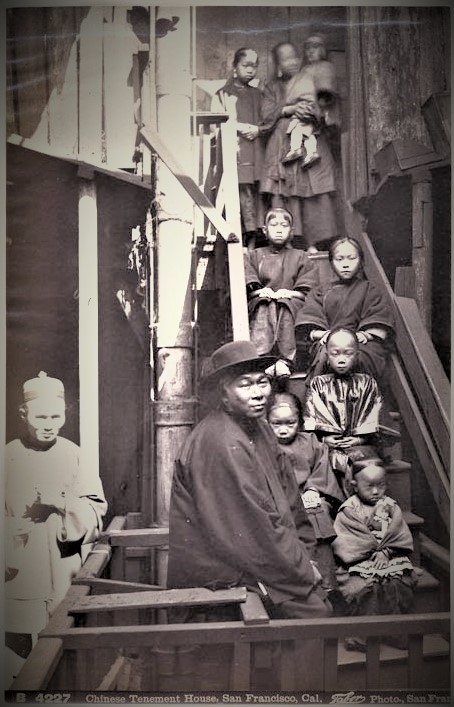
“B 4227 Chinese Tenement house, San Francisco, Cal.” c. 1884. Photograph by Isaiah West Taber (Martin Behrman Negative Collection / Courtesy of the Golden Gate NRA, Park Archives also from the California State Library). A Chinese father (or, as some viewers have more sinisterly implied, a “guardian”) for seven children and mother, posed on stairs leading to second floor entrance. A second man stands to left of the bottom of the stairs.

“B 5404 An Alley in Chinatown, San Francisco, Cal.” c. 1885. Photograph by Isaiah West Taber (from the Marilyn Blaisdell collection).
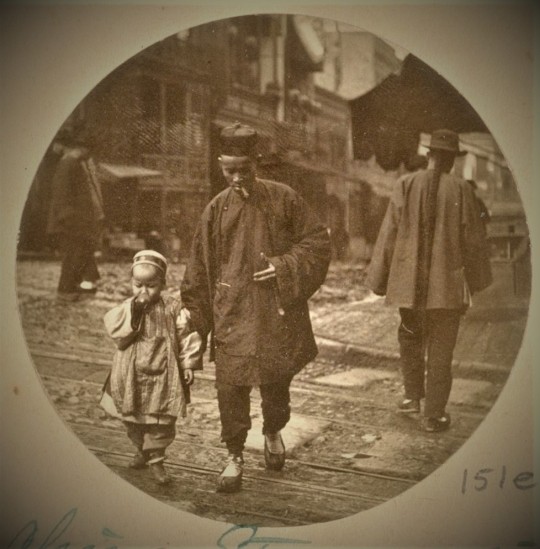
Cigar-smoking father and child crossing from what appears the northeast corner of Waverly Place and Clay Street, c. 1889. Photographer unknown (from the Jesse B. Cook collection at the Bancroft Library). In the background, the lanterns and façade of the Tin How temple appear on the west side of Waverly Place.
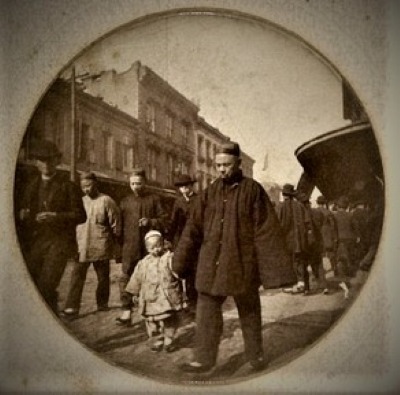
“Exterior View of Chinatown, San Francisco,” c. 1889. Father and child crossing a street. Photograph by Sam Cheney Partridge and printed by W.B. Tyler (from the collection of the Fine Arts Museums of San Francisco).

“Exterior View of Chinatown, San Francisco,” c. 1889. Father and child crossing a street, probably Dupont. Photograph by Sam Cheney Partridge and printed by W.B. Tyler (from the collection of the Fine Arts Museums of San Francisco).
Merchants in Chinatown carried the weight of responsibility on their shoulders. They built successful businesses, often establishing general stores, herb shops, or import-export enterprises. These fathers not only provided for their families' needs but also played a significant role in fostering economic stability within the community. They managed the intricate dynamics of trade, built networks, and navigated the challenges of language and cultural barriers. Through their entrepreneurial spirit, these fathers demonstrated perseverance, resourcefulness, and a commitment to creating a better future for their children.
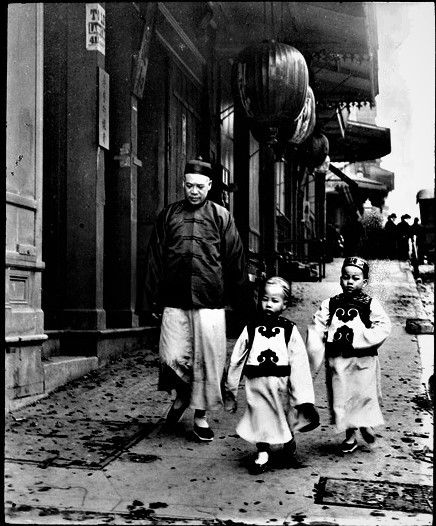
“Children of High Class” c. 1900. Photograph by Arnold Genthe (from the Genthe photograph collection, Library of Congress, Prints and Photographs Division). Merchant Lew Kan (a.k.a. Lee Kan) walking with his two sons, Lew Bing You (center) and Lew Bing Yuen (right). According to historian Jack Tchen, “Lew Kan was a labor manager of Chinese working in the Alaskan canneries. He also operated a store called Fook On Lung at 714 Sacramento Street between Kearney [sic] and Dupont. Mr. Lew was known for his great height, being over six feet tall, and his great wealth. The boys are wearing very formal clothing made of satin with a black velvet overlay. The double mushroom designs on the boys’ tunics are symbolic of the scepter of Buddha and long life.”

Father and child c. 1889. Photographer unknown (from the Jesse B. Cook collection at the Bancroft Library).
On the other hand, fathers working as laborers in Chinatown faced arduous working conditions and limited job opportunities. Many found employment in industries such as laundries, restaurants, or as laborers on the Central Pacific Railroad. These fathers toiled tirelessly to ensure their children had a better life than their own, often enduring long hours and physically demanding work. They displayed immense determination, resilience, and selflessness as they braved harsh conditions and discriminatory practices.

Young girls crossing the cable car tracks on Clay Street at the northeast corner of its intersection with Dupont under the watchful eye of their father, c. 1890. Photographer unknown (from the Marilyn Blaisdell collection).
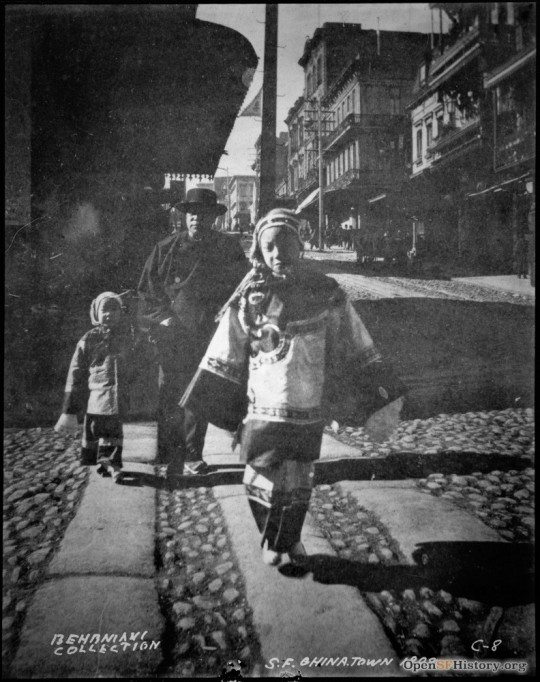
“S.F. Chinatown 1898.” Photographer unknown (from the Martin Behrmann Collection of the GGNRA). The daughters’ festive attire suggests that this image was taken during the Chinese New Year holidays. The incline of the hill, the appearance of the lanterns hanging from the double-balcony façade of the Yoot Hong Low restaurant at the right of the photo, and the cable car tracks in the background indicate that the trio were walking east on Clay Street and crossing Dupont Street from the southwestern to the southeastern corner of the intersection.
Regardless of their occupation, fathers in Chinatown shared a common goal: providing for their families and instilling values in their children. They recognized that education was the key to unlocking doors of opportunity and breaking free from the confines of poverty, if not segregation. Despite facing language barriers and limited resources, these fathers encouraged their children to pursue knowledge and acquire skills that would help them succeed in the ever-changing landscape of America.

Chinese American men and child in front of building with hanging lanterns, Chinatown, San Francisco, c. 1896 - 1906. Father and infant conferring with a smoking man on the sidewalk in front of a store. Photo by Arnold Genthe (from the Genthe photograph collection, Library of Congress, Prints and Photographs Division).
Fatherhood in old Chinatown was also a testament to the unwavering support and sacrifice made for the well-being of the family. Many fathers left their homes and families behind in China, enduring years of separation to seek better opportunities in the United States. Their commitment to their families was demonstrated through their remittances, which provided financial stability and, for a lucky few during the Exclusion era, allowed their loved ones to join them in the new world.

“A Holiday Visit” c. 1897. Photo by Arnold Genthe (from the Genthe photograph collection, Library of Congress, Prints and Photographs Division). According to historian Jack Tchen: “The baby is wearing Western shoes. The girl with the balloon is a member of the SooHoo family. She was one of three sisters and four brothers. She later married a Jung and had eight children. After the earthquake, her father was a carpenter for white families who needed skilled craftsmen to restore their houses.”

Father follows two children with another father and infant seen on the corner in the background, c. 1900. Photographer unknown (from a private collection). This image has been corrected from the opensfhistory.org website.

Father and child walking north on Dupont Street, c. 1900. Photographer unknown (from a private collection). The darker signage in the upper right reads: 仁安堂衛生鋈酒 (canto: “Yan On Tong wai saang yook jau”; lit. “Benevolent Peace hall hygienic liquor”).
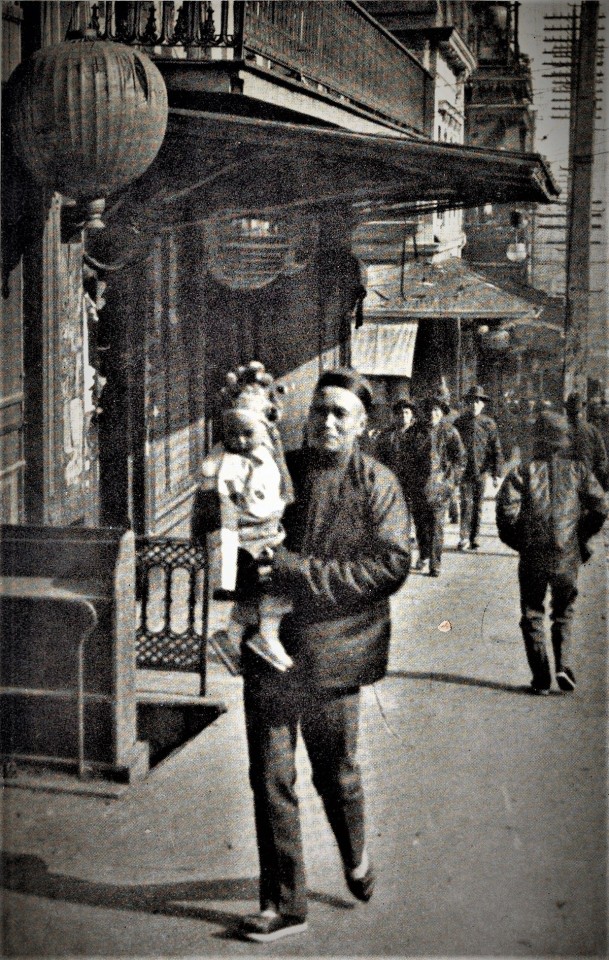
“New Year’s Day in Chinatown” c. 1900. Photograph by Arnold Genthe (from the Genthe photograph collection, Library of Congress, Prints and Photographs Division). “Nearly half of Genthe’s Chinatown photographs were taken during some community holiday,” historian Jack Tchen has written. “The merchant and child are walking westward up Clay Street just above Waverly Place. The lantern directly in line with the boy’s head is a sign for the Siyi [四邑; canto: “sei yap”], or Four Districts, Association located at 820 Clay Street.”

A father holds his child as he converses with two men whose faces are shadowed in front of a sidewalk stall. No date, photographer unknown (from a private collection).

“Paying New Year’s Calls” c. 1900. Photograph by Arnold Genthe (from the Genthe photograph collection, Library of Congress, Prints and Photographs Division). The two men and children appear to be walking south on Dupont Street and crossing to the southeastern corner of its intersection with Clay Street.
One can infer from the many photos that Arnold Genthe and other photographers took of fathers and holiday-garbed children that the photographers captured activities around the second day or “beginning” of Chinese New Year (開年; canto: “hoi nien”; pinyin: “kāinián”), including paying visits (or 拜年; canto: “bye nien”) to relatives for the renewal of family ties and to close friends for relationship-building.

“Scene in Chinatown San Francisco” c. 1900. Photographer unknown (from a private collection).

Photograph by Arnold Genthe (from the Genthe photograph collection, Library of Congress, Prints and Photographs Division). Historian Jack Tchen wrote about this image as follows: “. . . In [Genthe’s book] Old Chinatown this photo was entitled ‘He Belong Me.’ The bull’s-eye sign further down Washington Street indicates a shooting gallery. This block was only half Chinese.” The window signage seen in the immediate background shows W.D. Hobro, “Gas & Steam Fitting,” at 728 Washington Street, across from Portsmouth Square, ca. 1897. “Hobro ran a lucrative plumbing business serving the Chinatown area,” Tchen has written. “Chinese were not allowed into the plumbers’ union until the late 1950s.”
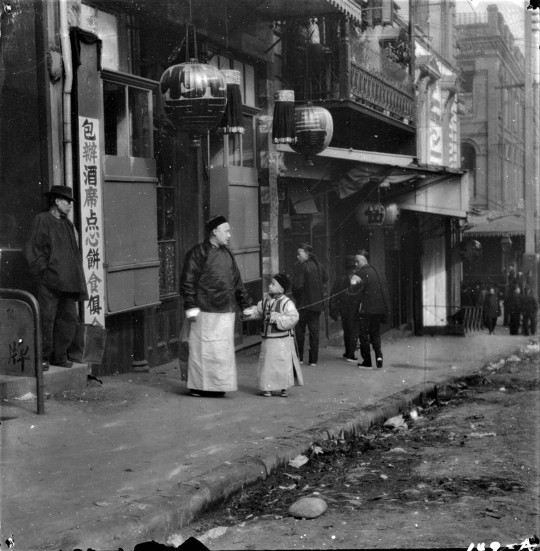
“A Family from the Consulate, Chinatown, San Francisco,” c. 1900-1906. Photograph by Arnold Genthe from the Genthe photograph collection, Library of Congress, Prints and Photographs Division. A father and son (with a balloon), attired as befitted a merchant family, walking west on the north side of Clay above Dupont Street. More modestly-dressed passersby stare at the pair, perhaps in recognition of the man’s status as a consular official. The long vertical signage parallel to the drainpipe in the left-hand part of the image has been damaged. Other photos from this period show the complete sign as 包辩酒席占点心餅食俱全 (canto: “bow bin jau jik tin dim sum behng sihk geuih chuen”) or 包辦酒席 “= can host banquet;” 點心餅食 “= dim sum bakery;” 俱全 “ = both or complete.” The writing on the lanterns at the ground floor identifies a restaurant as 悦香酒樓 (canto: “Yuet Heung Low”). The shuttered storefront of the Yoot Hong Low restaurant’s premises at 810 Clay Street indicates that the building was closed for the New Year holiday.

A father walks with his family north on Ross Alley, no date. Photographer unknown (from a private collection).
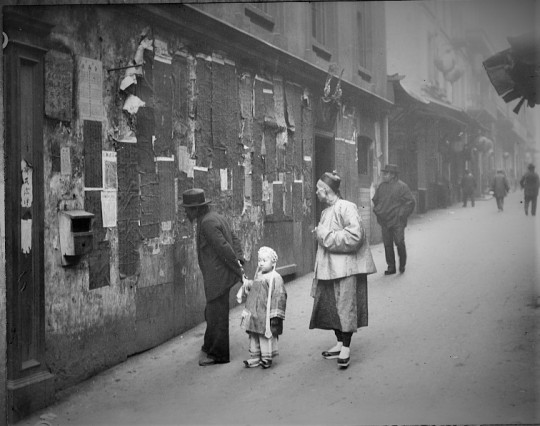
Ross Alley from Jackson Street, c. 1898. Photo by Arnold Genthe (from the Genthe photograph collection, Library of Congress, Prints and Photographs Division). Historian Jack Tchen: “The wooden box affixed to the wall on the left was for disposing of paper scraps. Genthe inaccurately entitled this photograph ‘Reading the Tong Proclamation.’ According to many guide pamphlets and books written during this time, these notices proclaimed who would be the next victim of tong ‘hatchet men.’ In actuality, they reported a variety of community news.”
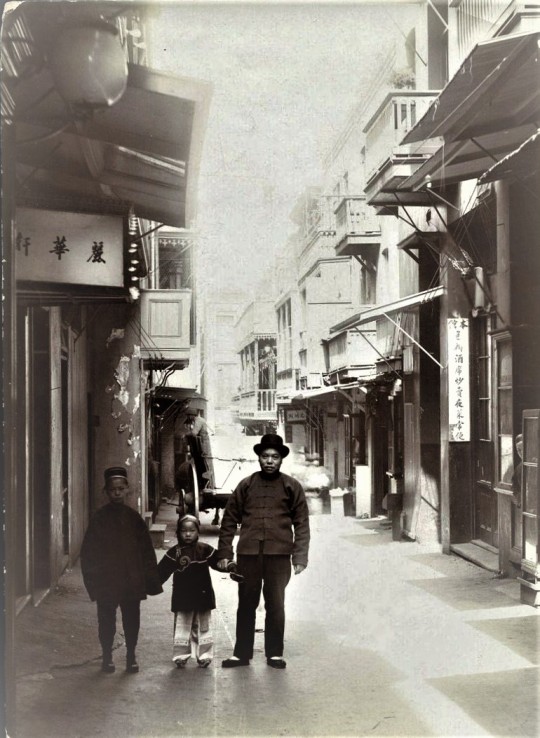
A Chinese merchant with his two children in Ross Alley of pre-1906 San Francisco Chinatown, c. 1902. Photograph attributed to Charles Weidner (from a private collection).

Chinese merchant and his children. Photographer possibly by Charles Weidner (from the Cooper Chow collection at the Chinese Historical Society of America). This image appears to be a continuation shot of the same trio of father, daughter and son Weidner took in Ross Alley. All three are wearing the same clothes and posing in front of what is probably the father’s business premises. Outside of his store, the merchant shows more of a smile as he looks directly at the camera lens, perhaps more familiar with the photographer. Even his son has started to show the beginning traces of a smile. This implies that the photographer either followed the trio from Ross Alley to the father’s place of business or encountered the merchant and his offspring for another photo. Prominent advertising signage appears above the doorway to the business which reads from right to left as follows: 廣珍號珍珠玉器金銀首飾男女新衣蘇杭發客 or roughly “Guangzhen Pearl Jade Gold and Silver Jewelry Men’s and Women’s New Clothes Suzhou and Hangzhou” (pinyin: “Guǎng zhēn hào zhēnzhū yùqì jīnyín shǒushì nánnǚ xīn yī sūhángfā kè “; canto: “Gwong Zun ho sunjiu yok hay gam ngan sau sik nam neuih sun yee so hong faat haak”). The barely discernible calligraphy on the upper-right pane of the store window frame bears the probable business name, 廣珍 (“Gwong Zun”). Magnification of the window reveals at several photographs that can be seen through the window. At least four framed photos are visible on a wall behind a desk. On the most discernible of the photos, a figure appears to be seated and holding a fan – a pose commonly used by Chinese subjects in the studio portraiture of the late 19th century. The figure could be an ancestor or even the merchant’s wife, as photos became essential evidence to overcome the hurdles to the effective denial of entry to the US by Chinese females after the enactment of the Page Act of 1875 which purported to bar the immigration of prostitutes. A couple of wooden shutters appear behind the merchant and his son. The panels would have been used to cover the window as a security measure. A similar set of shutters also appear at the far right of the photo frame, indicating the merchant shared this alleyway or street with other businesses. Unfortunately, the signage (appearing in the upper right-hand corner of the frame), for what appears to be a street number or street name is illegible.
The fathers of old San Francisco Chinatown were unsung heroes who forged a path for future generations. Whether as successful merchants or hardworking laborers, their contributions to their families and community were immeasurable. Their legacy is deeply ingrained in the history and fabric of modern-day Chinatown and the mythology of Chinese America itself, where their sacrifices and contributions are remembered and celebrated.
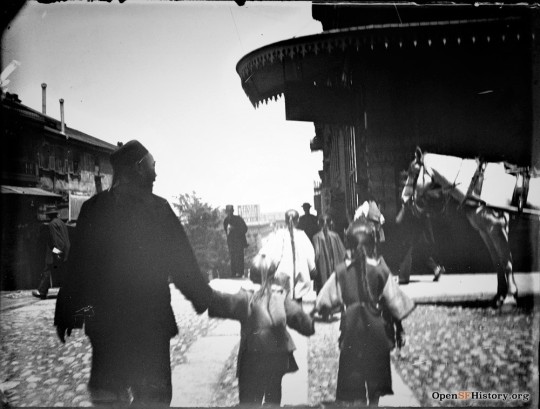
A father escorts his two children across Dupont Street, heading west down the hill on the south side of Clay Street, c. 1900. Photographer unknown (from a private collection). The trees of Portsmouth Square park can be seen in the distance.
Today, the descendants of these fathers continue to honor their heritage, proudly embracing their Chinese American identity while embodying the resilience and determination that their fathers instilled in them.
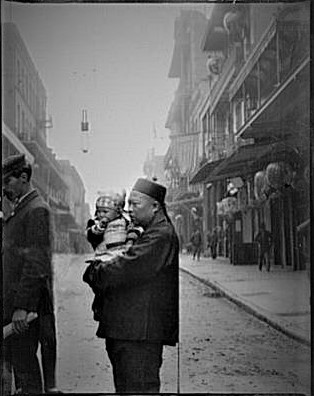
“A Proud Father” c. 1900-1905. Photo by Arnold Genthe (from the Genthe photograph collection, Library of Congress, Prints and Photographs Division). A father and child are seen crossing Dupont Street at its intersection with Clay Street from the northeastern to northwestern corner. The lanterns and balconies of the Wauy Sin Low restaurant at 808 Dupont can be seen in the background at right. According to historian Jack Tchen, “[a] man’s elbow has been etched out of the photograph. The object hanging above the street is an electric street light attached to a pulley. When the bulb burned out, the light would be pulled over to the side of the street and changed.”

“Man and boy walking on street” c. 1900-1905. Photo by Arnold Genthe (from the Genthe photograph collection, Library of Congress, Prints and Photographs Division). Based on his dress, the man appears to be a merchant. The boy’s festive dress indicates that the photo was taken during a holiday.

“Man and children walking down a street,” c. 1900-1905. Photo by Arnold Genthe (from the Genthe photograph collection, Library of Congress, Prints and Photographs Division).
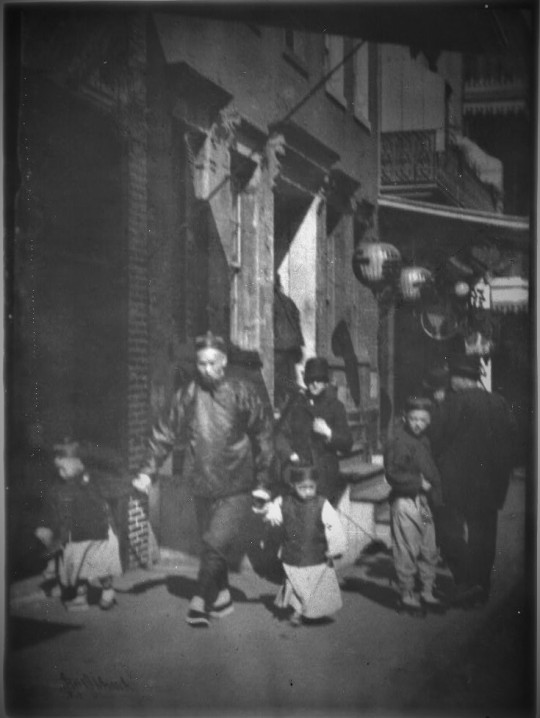
“Man and two boys walking along a street,” c. 1900-1905. Photo by Arnold Genthe (from the Genthe photograph collection, Library of Congress, Prints and Photographs Division). Based on his dress, the man appears to be a merchant. The boy’s festive dress indicates that the photo was taken during a holiday.

“Man and two children crossing a street,” c. 1900-1905. Photo by Arnold Genthe (from the Genthe photograph collection, Library of Congress, Prints and Photographs Division).

“Man and a young child walking,” c. 1900-1905. Photo by Arnold Genthe (from the Genthe photograph collection, Library of Congress, Prints and Photographs Division).

“Man carrying a child accompanied by another child,” “Man and two children crossing a street,” c. 1900-1905. Photo by Arnold Genthe (from the Genthe photograph collection, Library of Congress, Prints and Photographs Division).
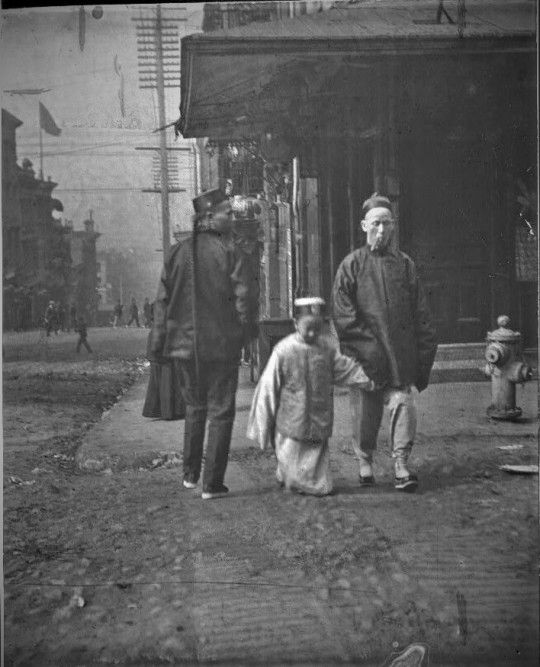
“Boy and a man smoking a cigar crossing a street,” “Man and two children crossing a street,” c. 1900-1905. Photo by Arnold Genthe (from the Genthe photograph collection, Library of Congress, Prints and Photographs Division).

“Waiting for the Car” c. 1904. Photo by Arnold Genthe (from the Genthe photograph collection, Library of Congress, Prints and Photographs Division). Historian Jack Tchen writes about this photo as follows: “The Sue family at a Dupont Street corner. Mrs. Sue is shown with her eldest daughter, Alice, with Elsie sandwiched between them. Her brother-in-law is holding Harris. Alice is wearing strings of pearls and semiprecious stones on her head dress. Mrs. Sue is wearing a black silk-on-silk embroidered outfit. Married women generally wore dark, subdued clothing that distinguished them from prostitutes. Elsie and Harris are wearing leather shoes; however, Alice and her mother wear Chinese-style footwear. Mr. Sue, who died after the 1906 earthquake, ran a doc sic guun, or “boarding house,” which fed male workers at nine in the morning and four in the afternoon, while Mrs. Sue took in sewing. (Information provided by Alice Sue Fun.)”
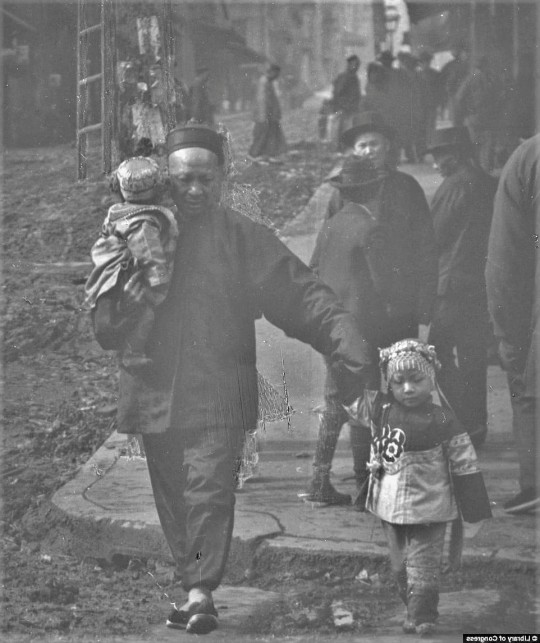
Father and two children walking downhill (probably Sacramento Street), c. 1904. Photo by Arnold Genthe (from the Genthe photograph collection, Library of Congress, Prints and Photographs Division). The girl’s festive dress indicates that the photograph was taken during the New Year holidays.

A sidewalk store proprietor/operator with his children, c. pre-1906. Postcard variant of a lithograph (from the collection of the Society of California Pioneers). Other card variants bear the caption “Chin Kee and family, Chinese Street Merchant, Dupont and Washington Sts. Chinatown, San Francisco” such as the card by Britton & Rey, Lithographers, San Francisco 515 (from the private collection of Wong Yuen-ming). To read more about the sidewalk stalls of old San Francisco Chinatown, go here.

“Dressed for a Visit” c. 1896 - 1906. Photograph by Arnold Genthe (from the Genthe photograph collection, Library of Congress, Prints and Photographs Division). Historian Jack Tchen: “This photograph happens to capture the sign for the ‘Chinese Newspaper/War Kee’ at 803 Washington Street, just west of Dupont Street. The War Kee was founded in 1875. Although the names J. Hoffman and Chock Wong appear as the publishers of the first issue, a Yee Jenn has been cited as the founder. The War Kee, which was the first successful Chinese weekly published in Tangrenbu, folded in 1903. [Note: The Langley directory for 1876 contains a listing in its newspapers section for "Oriental (Chinese) Chock Wong & J. Hoffmann, 817 Washington." This address would have placed its first offices on the south side of Washington Street across from the southern entrance to Ross Alley.]
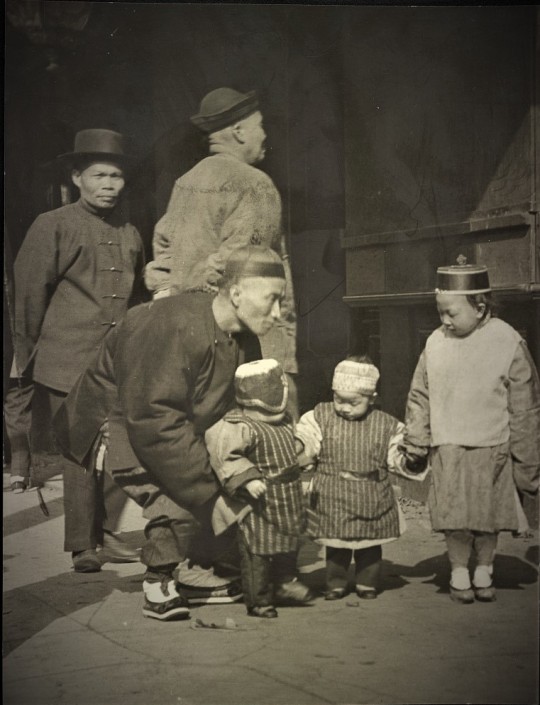
Chinese American men and three children in traditional dress standing on a street in Chinatown, San Francisco, c. 1896 - 1906. Photograph by Arnold Genthe (from the Genthe photograph collection, Library of Congress, Prints and Photographs Division).

“The Proud Father” c. 1905. Photo by Mervyn D. Silberstein (from a private collection). Silberstein specialized in photography of San Francisco Chinatown residents and producing hand-colored reproductions in “actual Chinese color combinations.” Silberstein’s own ads for his “Chinee-Graphs” promoted “[m]ost of these pictures were taken during the Chinese New Year festivities many years ago when the ancient customs were adhered to.”
[updated 2023-6-30]
#Chinese fathers of old San Francisco Chinatown#Lew Kan#Ross Alley#Dupont Street#Arnold Genthe#Sam Cheney Partridge#Chin Kee and family#Jack Tchen#Wauy Sin Low restaurant#A.J. McDonald#Charles Weidner
3 notes
·
View notes
Text

"This idyllic photograph entitled “window call” was taken by William Morris Grundy in 1857. He captures the rural life in England during the Victorian era. Born in Birmingham in 1806, Grundy took up photography in 1855 and made dozens of stereoscopic photos, primarily posed genre scenes of rustic pursuits such as hunting, fishing, and farming. The London Stereoscopic Company bought about 200 of his negatives, and individual stereographs still exist. However, Grundy’s work is best known for the twenty original albumen prints based into the anthology Sunshine in the Country, A Book of Rural Poetry Embellished with Photographs from Nature (London, 1861). He died in 1856.
https://www.getty.edu/art/collection/object/1040D2
https://mashable.com/feature/william-grundy-english-views
https://www.rct.uk/collection/2906231/reclining-smoker
https://rarehistoricalphotos.com/rural-victorian-england-photos-william-grundy/
> Steve Gallagher > Public Domain Photos and Images
0 notes
Text
Quaternions are coming in.
I’m trying to connect that to grid squares. The answer is, I think, as basic as it looks, that the Triangular attaches to the real, and thus we have the 3 imaginary dimensions in attachment to the real. That actually becomes a tetrahedron if you link each imaginary to the real in 0-1. This use of 1Space enables the attachment that we see in quaternions.
And the conception of 2 quaternions combining then should be invoking Hexagonal, which now occurs because each of the real attachment are 0 in Hexagonal. And that visualizes simply as a pole through the center of the Hexagon. Wow. And there are 6 cycles of multiplication, which are circles or cycles that start with i, j or k and return the same. That’s identification, so it means SBE2 expresses in quaternions as the count of these cycles.
And this explains why I see negatives now. That is, I noted yesterday that with my left eye structure contracted relative to the right (which can mean released wit the right contracted but closed), I can see the resolution choices in the objects, both images projected, and then stretching resolves those choices, which happens in layers.
Today I’ve switched perspective to lead from the body side. Example: I woke up and immediately did extremely deep alignment and contraction work. Even in bed, I twisted and contracted my feet more than I could before.
I have previously identified the source of anxiety in the dislocation when I change states, notably from asleep to awake, but also on the way down from a very good Understanding. The latter we have labeled shedding negatives. Shaking them off and becoming indifferent to them are two separate acts. To contrast, when shedding negatives, the pathways of doubt that were skipped or cut off reveal themselves. If those tend to ‘you are worthless’, those aren’t doubts about the work, but rather are what fills in when there aren’t doubts or when they’re not yet visible. The other form is more like everything that you did is in a past state, in a past incarnation separated by sleep from this. You thus see what you have constructed from the perspective of the object, of the real object, and that means 2 quaternions coming together.
This maps to the conception of D12 and D24 as 2 points, making 1-0-1 and SBE2, so D12 is if you connect End over End where each End is End over End. And D24 is that counted from a center so that result occurs in that axis.
This means that if you’re doing a projection, like a stereographic projection, then you get a positive and a negative. And the point is they exist until one is revealed, which is another description of choice, which I did not expect. That is, choice is a permutation pathway which exists until the path becomes clear. That’s a good description of how I’ve approached this in general, that I can’t know what I can’t know until I know it.
And this connects to the sK slicing off what I now see must expand into the complex unit circle around the real ordered line of the moment. That’s a triple or quintuple wow.
0 notes
Video
Any ideas? Yes! St. Doulagh's Church on the Malahide Road, Dublin by National Library of Ireland on The Commons
Via Flickr:
We didn't know where this one was taken. Our catalogue just said: "Square tower set in steep slated roof of small possibly ecclesiastical building, lady in foreground, whole in trees, fields." See below for super quick identification! Date: 1860s going by the dress? (definitely 1860-1883) NLI Ref: STP_0240 You can also view this image, and many thousands of others, on the NLI’s catalogue at catalogue.nli.ie
#Stereo Pairs#Stereographic Negatives#Stereoscope#James Simonton#Frederick Holland Mares#John Lawrence#Lawrence Collection#Ladder#Tower#Crenellations#Stone#Crinoline#Hat#1860s#Location Identified#Stereoscopic Collection#19th Century#Women#National Library of Ireland
5 notes
·
View notes
Text
Here’s something cool about early photography that I thought I’d share. If you watched my documentary, you probably saw pictures that looked like this:
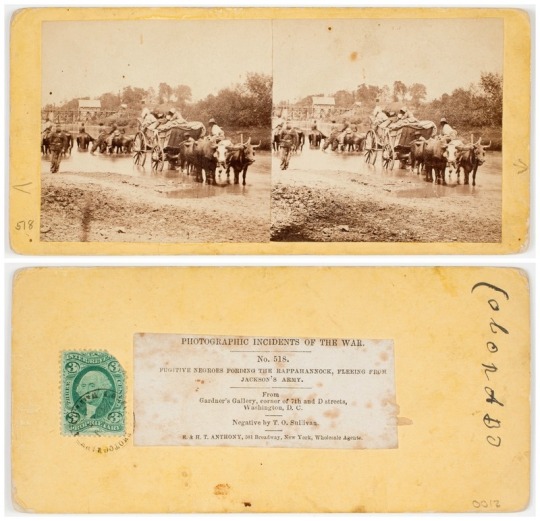
These pictures are called Stereographs and were the first step to 3-D imagery.

The idea of the Stereograph was to be like your eyes: turn 2 images into 1. A stereographic photographer would set up a camera with 2 lenses and then capture the same image. Now when we see the image, it looks the same. That’s because we don’t have a Stereoscope. When a viewer looked at the photographs through the stereoscope, they saw an image very similar to how you would see an image at a 3-D movie.

Original Stereograph and negative
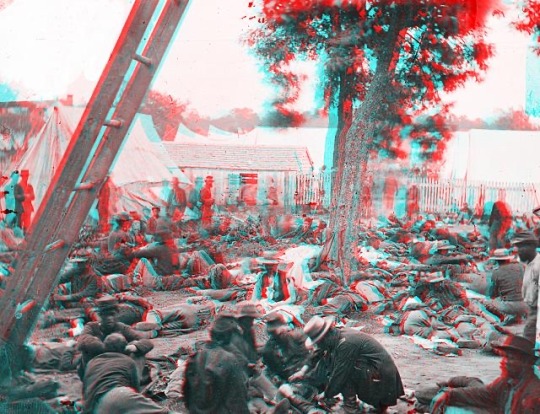
What a “modern” stereograph would look like
At the time these photographs were taken, this was a revelation and even to this day, it still is interesting to see how these early photographers used the resources they had available to create something that is, today, made almost completely digitally.
If you have any questions feel free to ask!
Here are some more examples of stereographs from the American Civil War as well as other places:
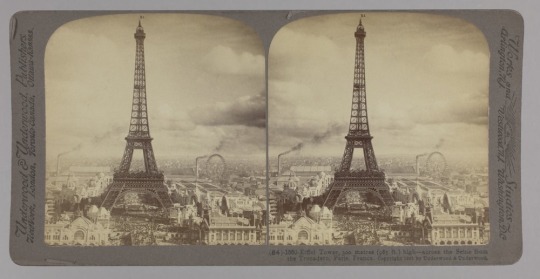
“(64)-1560-Eiffel Tower, 300 metres (985 ft.) High - across the Seine from the Tocadero, Paris, France. Copyright 1901 by Underwood & Underwood.”

“Preparing the Mess”

“General Sherman and Staff”
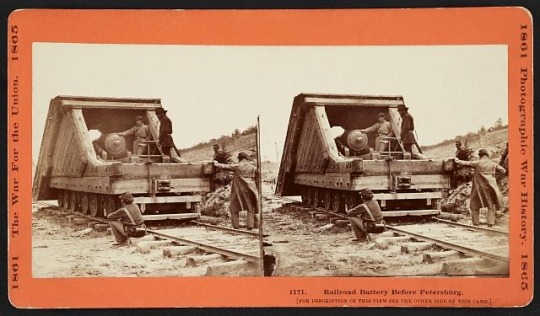
“Railroad Battery Before Petersburg” (this is actually a picture of a really cool weapon made during the US Civil War)
Sources: Library of Congress, American Antiquarian Society, Kansas Historical Society
#history#american history#american civil war#civil war#photography#stereograph#eyes#early photography#1800s#1860s#3D#illusion
20 notes
·
View notes
Photo

In light of the latest moon news, we're sharing a stereographic reproduction of negatives created by Henry Draper in the 1860s. Draper was a physician and pioneering astrophotographer who captured images of the moon, the transit of Venus, the Orion Nebula, and the spectrum of Jupiter.
Henry Draper, Full moon from negatives taken by Prof. H. Draper, with his silvered glass telescope, ca. 1863 (printed ca. 1875). Albumen on stereograph mount.
10 notes
·
View notes
Photo

[86 Stereographic Views of The International Exhibition of 1862] by William England, Metropolitan Museum of Art: Photography
Gilman Collection, Museum Purchase, 2005 Metropolitan Museum of Art, New York, NY
Medium: Albumen silver prints from glass negatives
http://www.metmuseum.org/art/collection/search/286659
8 notes
·
View notes
Photo

Animated stereoscopic portrait of a Chinese boatwoman in Canton (Guangzhou), China, 1869. By John Thomson.
Source: Wellcome Images.
#china#chinese history#history of china#history#animation#stereoscopic#stereograph#glass negative#boatwoman#canton#canton history#1860's#1860's fashion#wigglegram#portrait#stereoscopic portrait#studio portrait#john thomson#unidentified subject#guangzhou history#history of guangzhou#guangzhou#1869#victorian era#victorian age#victorian#victorian times#wet collodion negative
25 notes
·
View notes
Photo

🔸 This idyllic photograph taken by William Morris Grundy, capture the rural life in England during the Victorian era. Born in Birmingham in 1806, Grundy took up photography in 1855 and made dozens of stereoscopic photos, primarily posed genre scenes of rustic pursuits such as hunting, fishing, and farming. The London Stereoscopic Company bought about 200 of his negatives, and individual stereographs still exist. However, Grundy’s work is best known for the twenty original albumen prints based into the anthology Sunshine in the Country, A Book of Rural Poetry Embellished with Photographs from Nature (London, 1861). This picture is entitled “gent for sale” circa 1857 #victorianchaps #oldphoto #retro #victorian #humour #victorian #goodolddays #rurallife #vintage #1850 #pastlives #nostalgia https://www.instagram.com/p/Cpa2DpejxVF/?igshid=NGJjMDIxMWI=
#victorianchaps#oldphoto#retro#victorian#humour#goodolddays#rurallife#vintage#1850#pastlives#nostalgia
4 notes
·
View notes
Photo
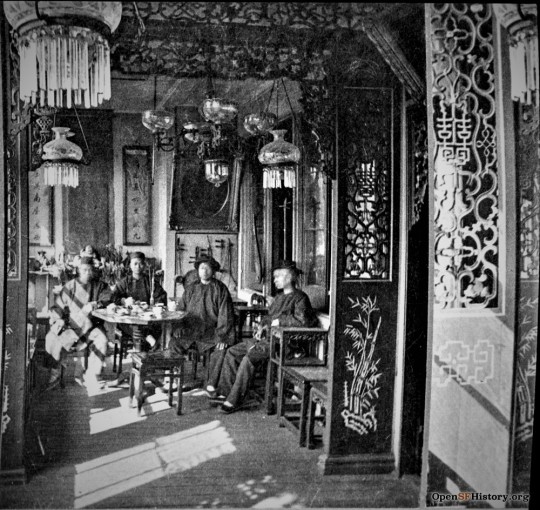
Interior view of four men around a tea table c. 1870′s (Photograph by Carleton Watkins -- Marilyn Blaisdell Collection). The tea room was probably located in the Yuen Fong Low restaurant (遠 芳芳樓) at 710 Jackson Street in San Francisco Chinatown.
Scenes from the Tea Room of the Yuen Fong Restaurant (遠 芳樓) on Jackson Street
Traveling the American West, Carleton E. Watkins (1829 - 1916) made thousands of mammoth and imperial plate photographs of the scenery found in the Yosemite Valley, Columbia River, the Sierra Nevada, and the Pacific Coast in Oregon. Many credit Watkins’ photographs of the Yosemite Valley as a key factor in Congress’ designation of Yosemite as a national park in 1864.
The master of late 19th century photograph also included San Francisco's Chinese quarter in his studies of pre-1906 San Francisco.
As Kelley Wolfe of the UCLA Library Special Collections wrote in 2017, “[d]uring the winter of 1871-72, Watkins expanded his San Francisco gallery (the Yosemite Gallery), which put an extra strain on his finances. When the Bank of California went under in 1874, Watkins lost his Yosemite Art Galley to competitors J.J. Cook and I.W. Taber. Not only did his competitors take over his Gallery, they took all of his negatives as well. Watkins then began the task of rebuilding his collection, which meant re-photographing many of the sites he had visited earlier in his career. "Watkins's New Series" of views replaced those lost in the foreclosure. Watkins did become re-associated with the Yosemite Gallery, first as a photographer, and later as manager, but never as the owner.”
From his studio-showroom, located a couple of blocks away on Montgomery Street, Watkins photographed numerous locales in or about Chinatown during the 1870’s and 1880’s. However, one series of stereographs -- all taken in one room – continue to delight viewers to this day, and gained particular mention by Stanford professor Gordon H. Chang in his book, Ghosts of Gold Mountain: The Epic Story of the Chinese Who Built the Transcontinental Railroad. The first two photographs here are considered in the order addressed by prof. Chang as follows:
“One of the most prominent photographers working in California at the time of the Transcontinental was Carleton Watkins, who established the studio on Montgomery Street in San Francisco in 1871, shortly after the railroads completion. Located just a few blocks from Chinatown, Watkins’ studio employed several Chinese to help reduce his stereographs and other images, and the products of their laborers often feature Chinese as well. More than thirty extant Watkins images have Chinese as the main or partial subject. His photographs of Chinese in San Francisco show them in Chinatown stores, temples, restaurants, and smoking establishments. His most arresting images are from the 1870s.
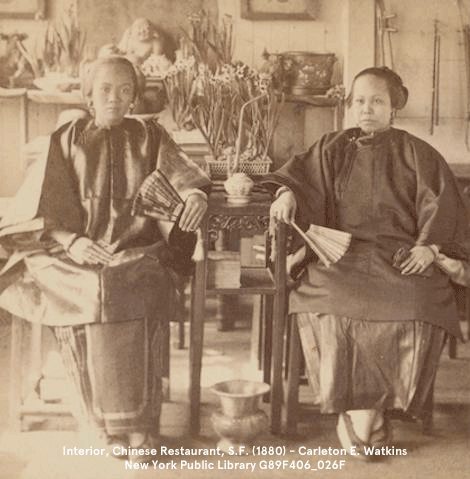
“Interior, Chinese Restaurant, S.F. (1880)” – Carleton E. Watkins. From the collection of the New York Public Library
"’Chinese Women, San Francisco’ [above] shows two fantastically silk-gowned women in a bright sunlit room full of Chinese tropical hardwood furniture, traditional string instruments, and art calligraphy. Partially visible elegant inscriptions declare that the owner of the artwork is a cultivated person. The setting is unlike anything most Euro-Americans at the time could ever have imagined existing on American soil. The women, who may be mother and daughter, seem relatively at ease; they do not appear to have bound feet (which suggests they are either Hakka or Manchu neither of whom engaged in the practice), and are clearly well-to-do. They hold painted fans, wear jade bracelets and rings, and are elegantly coiffed and groomed. An opium pipe sits on the table between them. . . .

“Interior Chinese restaurant, S.F. 3764″ circa 1875 (Photographer Carleton Watkins. Courtesy of Getty Open Content Program)
“A few moments later, to judge from the shifting shadows, Watkins took a second photo, ‘Chinese Actor, San Francisco’ (below) showing a young man in a spectacular Chinese opera costume. . . .

“Chinese Actor, S.F. 3765”
“. . . It must have shimmered and glowed with brilliantly colored socks and embroidery and red, blue, and gold thread,” Chang surmises. “He may very well have performed for Railroad Chinese in the Sierra or when they came to San Francisco for a visit. The altar behind him features of fine ceramic rendition of budai, the "laughing Buddha," the spirit of goodwill and happiness. The flowering narcissus and citrus fruit, possibly pomelo, indicate it is the time of the Spring Festival or Chinese New Year, a January or early February.” (Chang, p. 48)
As Prof. Chang’s book served a more expansive narrative about the Chinese role in the construction of the Transcontinental Railroad, his observations about Watkins’ work on that particular photo-shoot ended there. Consideration of various other prints of the same set of photos discloses a bit more information about the series from which additional deductions may be made.
Fortunately, a print of a wider angle of view of the daughter-mother and actor photographs still exist in other formats and which contain a captions confirming that the photographs were taken in a restaurant.

“B 3764 Interior, Chinese Restaurant, S.F.” Watkins’ New Series, Yosemite and Pacific Coast, 26 New Montgomery St., under Palace Hotel, S.F.
The caption on the card confirms that Watkins took the photo in a Chinese restaurant. One can also see in the extreme right side image that a sheet or curtain was hung opposite the windows; the sheet either simplify the scene or, more probably, reflect light back toward the subjects of the photo.
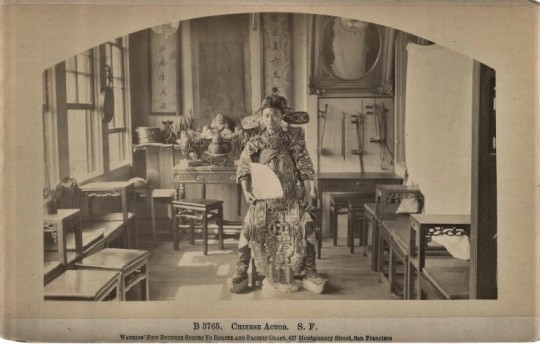
“B 3765. Chinese Actor. S.F.” c. 1870s. Photograph by Carleton Watkins (from the collection of the Getty Museum).
Similarly, a wider angle photograph of the Chinese actor may also be found in various collections. For example, the Getty has the above version of this image captioned in manuscript. As the Downtown Brown Books site states, Sotheby's sold an image very similar to the Getty's as part of a lot of boudoir views (on April 6, 2013), with a letterpress caption that included Watkins' street address with the note, "under Palace Hotel, S. F." Both the Getty and Sotheby's versions show not only the actor standing in the center but also show more of the wall decorations behind him and white curtain used for the session. This camera’s angle is also shifted slightly to the left.
The Downtown website declares that “Watkins is known to have employed a Chinese-American darkroom assistant, Ah Fue, who may have helped give him access to people and locations not normally visited by white photographers. Based on Peter Palmquist's checklist of Watkins' stereoviews—one of which was a cropped version of this photograph—this image likely dates from the late 1870s.” The curator for the website speculates about the identity of the actor as follows:
“According to the Sacramento Bee (7 March 1879), Long Yow was the leading male Chinese actor of the day in San Francisco, earning $6700 per year performing in Chinatown's two theaters. This image could be him or one of the half-dozen other leading players on the stage at the time.”
A third photograph which was probably taken on the same day as the aforementioned two stereographs is seldom mentioned, and it conveys additional, important information applicable to all of the photographs.

“B 3764 Interior Chinese Restaurant, Jackson St., San Francisco” c. 1870′s. Photograph by Carleton Watkins (from the collection of the California State Library).
The state librarian observes that the photograph shows a “seated man and woman in traditional Chinese dress, holding fans. Scattered tables line edge of room, flowers in pots along back wall. Two framed calligraphic texts on back wall, a framed painting to right, below painting a display of Chinese musical instruments. Possibly photographed by Carleton E. Watkins.”
A comparison with the preceding photos will disclose that the state librarian’s speculation was well-founded. The photo not only shows the same room in which photographs were taken of the actor and the daughter with mother, but the same older woman now appears in the third photo with a second person whom one can presume is her merchant husband. The background details are identical to those seen in the other two photographs. Additionally, we now know the approximate location of the restaurant in which the entire photographic series was produced, i.e., Jackson Street.

“Interior Chinese restaurant, S.F. 3762” circa 1875. Photographer Carleton Watkins c. 1875 (from the New York Public Library, Robert N. Dennis collection of stereoscopic views)
The above stereograph shows four men sitting in the same restaurant sitting-room as the photos of the Chinese actor and merchant couple, plus daughter. The image appears candid, devoid of any indication that the subjects were posed and the lighting prepared. The articulated screen panels used by Chinese restaurants of that day outside of the room are open, allowing sunlight from windows to play across the floor in the foreground. The number “3762” indicates that the photograph may have been taken earlier in the 3760-series of Watkins’ photos discussed above, perhaps when Watkins or an assistant scouted the location.
As to the location for the shoot, the merchant-spouse photo appears to rule out the established and well-known restaurants such as Hang Far Low and Woey Sin Low in the 700 and 800 blocks of Dupont Street. The Jackson St. clue prompts the question as to which restaurant’s room on that street served as the location for this fascinating series of images.
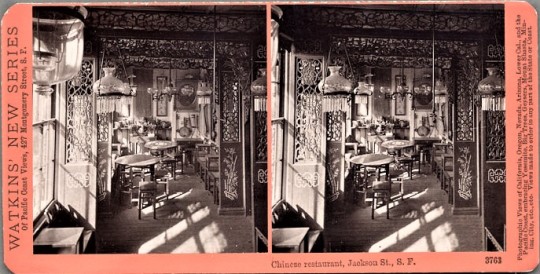
Chinese restaurant, Jackson St., S.F. 3763 (Photographer Carleton Watkins from the collection of The California Society of Pioneers)
The number 3763 in the series and as shown in the above stereograph of the same, but empty, room implies that Watkins took a photograph of the room after the quartet of tea drinkers shown in number 3762 had departed.
The next earlier photograph in the numerical series, no. 3761, shows the exterior of a restaurant on Jackson Street. Based on the series numbers, one can reasonably infer that Watkins took his first photo of the exterior of the restaurant to which he would gain access for his tearoom photo series.
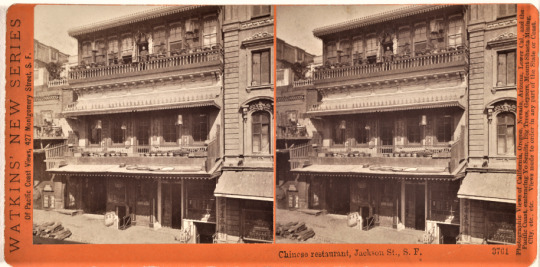
Chinese Restaurant, Jackson St., San Francisco. 3761 (Photographer Carleton Watkins from the collection of Bill Lee)
Thanks to a couple of other photos of the north side of Jackson Street (between Dupont and Stockton Streets), plus information from available business directories for the range of years during which Watkins took his photographs, the name and address of the Jackson Street restaurant can be established.

From "Chinese Restaurant, Jackson Street, San Francisco [California]. Watkins' New Series 3761" Photographer: Carleton E. Watkins (UC Berkeley, Bancroft Library). The Globe Hotel building, at the northwest corner of the intersection of Dupont and Jackson streets, appears to the right of the frame.
Collector Wong Yuen-Ming’s examination of the very fragmentary signage seen at the ground floor level indicates the presence of an herbalist shop (identified by the 各省生熟藥材 signage on the adjacent building east, down the slight street incline and in the right-hand side of the frame). An examination of the contemporaneous business directories for Chinatown discloses that the only restaurant with an adjacent apothecary address occupying the street during the period in which the photo was taken was Yuen Fong [遠芳; canto: “yuen fong”; lit. “distant fragrance”] & Co. at 710 Jackson and either the Quong Chi Tong or (by the 1885 Langley directory publication), the “Oy Wo Tong & Co. druggist” at 708 Jackson.
Both Yuen (a.k.a. Yune) Fong restaurant and the herbalist store had established themselves during the 1870’s.

Listing for the “Yuen Fung Low” (遠芳樓) restaurant at 710 Jackson Street in the 1871 Wells, Fargo Co’s Express directory of “Address of Principal Chinese Merchants in San Francisco, in Chinese and English, for the guidance of our Agents in Addressing Letters.”
The establishment of the businesses during the prior decade at 708 and 710 Jackson Street assured that their land uses were noted on the San Francisco Board of Supervisors map of Chinatown in July 1885.

Detail of the 700-block on the north side of Jackson Street, July 1885 (from the Cooper Chow collection of the Chinese Historical Society of America). showing a Chinese drugstore and restaurant, respectively, at 708 and 710 Jackson street.
The earliest mention of the restaurant as “Yuen Fong & Co., (Chinese) restaurant 927 Dupont” appears in the Langley directory of 1868. By the publication of the 1871 Wells Fargo directory of Chinese merchants, the restaurant had moved to Jackson Street (and Langley directory of 1871 lists the name as “Yune Fong, (Chinese) restaurant, 710 Jackson” but garbles the name in 1876 with typographical errors as the “Yone Fong, 1710 [sic] Jackson”).
As indicated by its telephone number listing of “China 67” for the “Yuen Fong & Co, Restaurant 710 Jackson” in the AT&T directory of 1905, the Jackson Street restaurant which commanded Watkins’ attention would operate until the disaster of 1906. Regrettably, the restaurant, the setting for a captivating set of images, would not re-establish itself in the rebuilt Chinatown.

“6661 Jackson St. Chinatown. S.F.” no date. Photographer unknown (from the collection of Wong Yuen-Ming). The Yuen Fong restaurant (遠芳樓; canto: “Yuen Fong Lauh”) at 710 Jackson Street, with its larger canopy over the second floor balcony, is seen at the center of the photo. The higher elevation of the Globe Hotel located at the northwest corner of the intersection of Jackson and Dupont streets is seen right of center.
[updated: 2023-4-29]
#Jackson St restaurant#Yuen Fong 710 Jackson St.#Carleton Watkins#Gordon H. Chang#Ghosts of Gold Mountain#Globe Hotel
4 notes
·
View notes
Video
On the rooftops of London. Coo, what a sight! by National Library of Ireland on The Commons
Via Flickr:
With the weather being a bit grim in Ireland today, thought we might go all Mary Poppins and take ourselves off over to London for a change. Can't identify any individual business except for Stokes Leather Warehouse (see note), and it'd be great to get some idea of the spot from which this one was taken (over to you, mapping gurus)... Date: 1860-1883 NLI Ref: STP_0424 You can also view this image, and many thousands of others, on the NLI’s catalogue at catalogue.nli.ie
#St. Paul's Cathedral#London#England#United Kingdom#UK#Cathedral#Factories#Chimneys#Stokes Leather Warehouse#Warehouses#Stereo Pairs#Stereographic Negatives#Stereoscope#James Simonton#Frederick Holland Mares#John Lawrence#Lawrence Collection#St#Paul's#Stereoscopic Collection#19th Century#National Library of Ireland
0 notes
Photo

Stereographic Moon, circa 1880, made from the negatives of astrophotography pioneer Henry Draper.
72 notes
·
View notes
